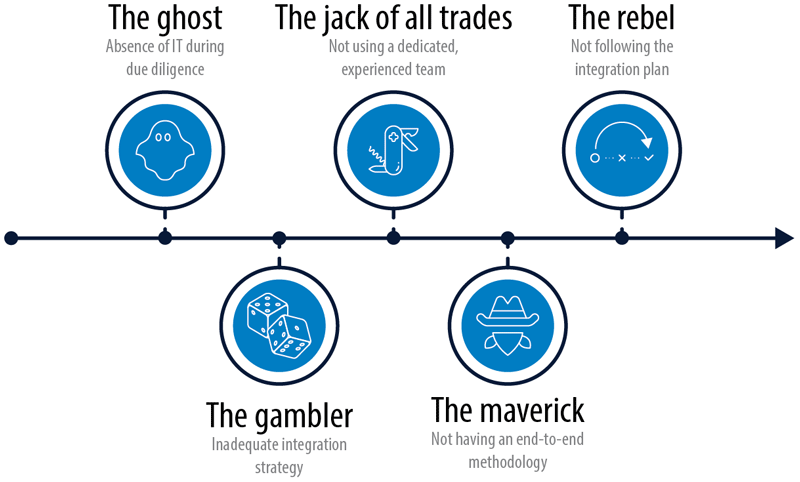Insights
- For a successful business merger, IT integration must involve the same precision as deal making.
- Five pitfalls should be avoided when merging companies. These include absence of IT during due diligence; having an inadequate integration strategy; not using a dedicated, experienced team; not having an end-to-end methodology; and not following the integration plan.
- Firms that avoid these pitfalls will realize the expected benefits, and find the right balance of leadership, IT synergy and expertise that can drive forward a post-merger integration plan.

It’s tempting to think the job is done once a merger is agreed and signed on the dotted line. But the reality is that the hard work has only just begun: to realize the benefits, the integration must involve the same precision as the deal making.
Most merged organizations fail to realize expected benefits: statistics show 70% to 90% of deals fall short.
Most mergers don’t lift operating profit. Even so, M&A deals involved a staggering $5 trillion globally in 2021, and deal numbers have surged 40-fold in 40 years.
What goes wrong?
That’s where the big problem lies. According to Gartner, at least a quarter of M&A integration effort comes from IT, and more than half of integration activities strongly depend on IT – yet, firms fail to effectively manage this crucial element of a merger.
We recommend organizations must avoid the five pitfalls shown in Figure 1 for a successful integration.
Figure 1. The five major pitfalls in an IT M&A integration

Source: Infosys Consulting
1. The ghost (the absence of IT during due diligence)

70%
of process and systems integrations fail at the beginning, not at the end. Inadequate IT integration hypothesis and execution are the top reasons.
Source: Process and Systems Integration: A New Source of Competitive Advantage, Bain
M&A processes such as infrastructure, applications, and systems integration often neglect the early involvement of IT functions, which hinders firms from capturing true business value. Without IT, firms face problems such as inadequate technical fit assessment and inaccurate business enablement analysis. IT involvement ensures apt technological capabilities of the merged entities and a-priori limitations of the target company. This provides insight into whether the technology can be integrated seamlessly into the existing operations.
Technical fit assessment
A thorough IT due diligence reveals vital information for better estimates of timelines, efforts, and costs.
This involves a review of:
- The target company’s competencies, capabilities, compatible standards, and architectures, including integration opportunities and challenges.
- Cybersecurity risks, compliance with data protection and privacy regulations, and security policies.
Business enablement analysis
When businesses exclude IT in the initial setup, they miss accurate analysis of business-technology enablement potential.
This IT analysis reveals:
- Commercial and financial opportunities through digital transformation.
- Improved marketing or sales targeting through acquired data analytics capabilities.
For example, a leading US bank prioritized IT in its significant acquisition of a large data analytics company. The bank experienced a smooth integration of digital and mobile banking infrastructures, uninterrupted online services, and advanced data protection.
2. The gambler (inadequate integration strategy)

60%
of M&A deals don’t have a standardized approach for the execution of post-merger integrations (PMI)
Source: From buying growth to building value, BCG
A post-M&A IT integration strategy, led by senior leadership, is pivotal for a successful IT integration. Without it, the integration may face challenges such as misalignment with M&A transaction objectives and loose IT integration governance. Doing strategy well ensures clear integration targets, priorities, success metrics, non-negotiables, and the extent of the integration.
M&A transaction objectives
IT integration teams must track IT-defined strategic objectives of the M&A transaction. This process defines high-level expectations for the merged IT landscape, anticipates synergies, establishes final integrated capabilities, and identifies key integration drivers.
To do this well, firms should institute:
- A plan that prioritizes cost synergies over other objectives.
- A capability-driven integration that focuses on identifying and assimilating specific capabilities, expertise, or talent.
IT integration governance
Integration teams face difficulties without the right IT governance in driving project activities, organizational changes, and processes. This executive-level group provides direction and defines decision-making procedures. It acts as the driving force for the integration steering committee, integration management office, and functional integration teams.
Getting this part right provides:
- Guiding principles for an efficient decision-making framework.
- Interaction with the corporate integration office to align and prioritize projects. The stakeholder communication strategy includes cross-company socialization and status reporting.
In a significant acquisition in the life sciences industry, the strategic directive of using a free transitional services agreement (TSA), regulatory compliance assurance, and data integration as the main concerns smoothened and expedited the merger process.
3. The jack of all trades (not using a dedicated, experienced team)

60%
of companies with failed IT integration did not have a dedicated team assigned to the endeavor.
Source: From pre-deal to all systems go, IMAA Institute
Dedicated and experienced integration teams lead successful M&A integration. If the integration team isn’t dedicated to the project and is involved in day-to-day operations, it may hamper integration and regular business functions. The overall effort will then face potential risks to operational delivery and integration exposure due to inexperience. On the other hand, an experienced team will enable the firm to preserve and enhance deal value.
Operational delivery
While deploying an existing team for post-merger integration has its benefits, it often negatively impacts run-the-business activities and destabilizes operational delivery. Mismanaged capacity may have suboptimal integration outcomes.
Key reasons to avoid this situation include:
- One or both integrated companies will undergo a significant operating model transition with complex live systems changes and migrations.
- Integration team members are expected to be change agents, not simply process coordinators or project managers. There is an obvious authority conflict between keeping stability while driving change.
Integration exposure
For most companies, acquisitions are infrequent events, and post-merger integration is normally not a core skill in their teams. Executives, line managers, and employees typically don’t deal with complex undertakings such as M&A.
An experienced team has:
- Deep understanding of the M&A IT integration process, risks, and challenges, with a methodology and toolkit to manage it.
- Strong technical expertise across key IT areas allow collaboration and effectiveness to handle issues during IT integration.
A major pharmaceutical player partnered with an M&A integration specialist to deploy a serial acquisition strategy. The company’s key resources could focus on a faster assimilation of research, expansion of their treatment and therapy portfolio, and a quick enablement of newer distribution channels.
4. The maverick (not having an end-to-end methodology)

60%
of firms undergoing M&A integration say they don’t have a comprehensive end-to-end M&A process model.
Source: Winning at the acquisition game, Timothy Galpin
A post-merger integration methodology acts as a guide with specific steps, including processes and accelerators, designed to help meet deadlines. Benefits include realizing value at a low cost and enhanced business stability.
Realizing value at a low cost
Inefficiencies from duplicated efforts and wasted resources mean it takes longer to realize the benefits of the merger. This restricts financial outcomes. Failure to coordinate integration teams leads to disorganization, delays, and frustrated and demotivated teams. On the other hand, following an end-to-end process model means value is built up early in the M&A journey, and efficiencies accrue due to the alignment of incentives.
“In general, most companies understand the risk of business disruption and revenue leakage that could ensue following an acquisition,” says Deepak Pajankar, a partner within Infosys Consulting’s Cloud Advisory practice. “But often companies are less prepared to experience the afterburn effects, and in retrospect, companies that apply robust post-merger integration methodologies thrive and deliver shareholder value sooner rather than later.”
Business stability
The stability of core business operations is a priority. But this can be overlooked if processes aren’t in place to assess and safeguard critical processes, data, and systems, manage risks, and apply contingency planning.
A well-planned process includes:
- Early identification and protection of core business processes, with prompt identification and resolution of additional issues.
- Guidelines to categorize, prioritize, and mitigate risks and compliance requirements of contractual obligations.
5. The rebel (not following the integration plan)

70%
of post-merger integration value erosion is found to occur during the final integration phase. This is due to integration errors and inadequate integration planning.
Source: Insights into Mining: Issue 8 - Post Merger Integration, KPMG
The longer the integration takes, the lower the likelihood of expected outcomes. Driven by the urgency to swiftly integrate their organizations and realize benefits, many firms often resort to rushed steps, shortcuts, or even bypassing crucial planning activities. Such actions lead to incomplete system integration design and planning, along with ambiguous organizational transition planning.
System integration design and planning
Skipping key steps in design or planning results in ineffective integration plans that require longer remediation, debugging, and testing, with potential data loss or downtimes. There are also issues with capacity, performance, and scalability management that risk future operational implementation. On the other hand, getting this part right increases automation, streamlines processes, and empowers team members.
Organizational transition planning
Without proper workforce transition planning and change management, businesses risk employee satisfaction and lose talent.
Firms must:
- Develop a workforce strategy for functional, cultural, and identity integration.
- Create effective communication and change management plans for better visibility and employee engagement.
In the divestiture of a market-leading life science corporation from its parent, a disciplined planning and design process ensured the streamlined separation of operations, allowing both to transition smoothly toward independent growth.
Putting it all together
Successful mergers, acquisitions, or divestitures extend beyond deal making. Careful planning and early IT involvement make a huge difference.
“A successful merger or acquisition goes beyond the deal and signing on the dotted line,” says Pajankar. “Rather, success depends on how well a company can internalize its strengths and weaknesses and find the right balance of leadership, IT synergy and expertise that can deliver the necessary tailwinds to drive forward a post-merger integration plan.”





